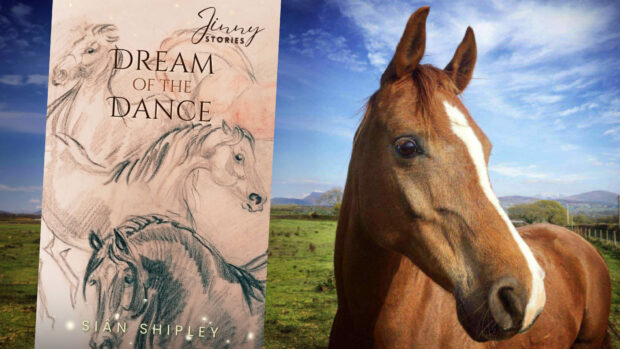Taking My Time is a new book written by former jockey George Baker, and tells the story of his successes in the saddle and adapting to a life out of it following his horror fall while racing on the snow in St Moritz in 2017.
George’s biggest win came when he rode Harbour Law to victory in the Doncaster Classic, the St Leger. Despite his battles with the scales — being unusually tall for a Flat jockey — George’s career as a jockey was going from strength to strength, but when the terrible accident left him with serious head injuries, he was forced to restart his life again. He was the same person, but different.
New obstacles had to be overcome, with the trauma not only physical but also psychological. In this book, the story is told with George’s wit and wisdom for which he is admired, with recollections from his wife Nicola, and those closest to him, about the impact his accident had on them all.
In this extract from the book, George recounts the moment when his life changed forever:
“If someone offers you the chance of a weekend in St Moritz, you jump at it. The Swiss ski resort welcomes the international jet set during the winter, and for us jockeys there is the White Turf, a short series of race meetings on Sundays, held on the frozen lake at the end of the town. The racing is of only a moderate standard, although the prize money isn’t bad, but the main attraction for me was the thought of a good night out afterwards. A few other jockeys had told me that the hospitality and the parties were worth experiencing.
“Adam Kirdby was supposed to be going to St Moritz to ride for the trainer Jamie Osborne and the Melbourne 10 syndicate, who were sending a few horses across. However, his main trainer Clive Cox had a runner at Wolverhampton on the Saturday night which he would be required for, meaning there would not be enough time for him to get there. Jamie rang me while I was having a game of golf with David Probert to ask if I would stand in for Adam. David had heard it was brilliant fun too, so why not give it a try?
“The only person who’d been a bit dubious about the adventure was Joe Fanning, one of the most sensible, father-figure members of the weighing room. ‘You’re mad,’ he said, implying that the racing was something of an acquired taste and not perhaps the safest thing to do.
“Saturday’s racing didn’t go brilliantly. I rode another of Jamie’s horses, Battalion, in the Winter Derby at Lingfield, but he sat down in the stalls, missed the break and didn’t have the best of runs to finish sixth, before I rounded off the day just getting beaten in a handicap on Etaad. From there it was straight to Heathrow on a flight to Zurich and a two-and-a-half-hour taxi journey through the mountains.”
The lights were on, but there was no one at home
“It was only waking up the next morning that I appreciated the beauty of the place. The very swanky hotel I had been put up in had a view all the way to the track, and the stunning scenery of the snow-covered Alps beyond.
“From what I could tell from the Swiss racecards, it looked as if all of my four rides had a chance, and when I went down to have a walk on the track, it looked great. John Best, who also had runners there that day and had had a winner when they had staged an extra meeting the previous Friday, had been encouraged about how well it had been riding, too. Although you see snow on the surface of the track, you are, of course, racing on ice underneath and around quite tight bends, which is very different to grass or all-weather tracks. Along with conventional racing, there are some races for locals called ‘skijoring’, which is where skiers are pulled along by horses. Apparently they can take a fair bit of punishment from bits of ice being kicked back in front of them.
“I had ridden my first mount of the afternoon, Boomerang Bob, once before a month or so earlier in a little handicap at Lingfield. Although not exactly a superstar, he was a solid sort of horse, and seemed fine on the track when we cantered down to the six-furlong start. I noticed that Dougie Costello’s horse, who was going along in front of me, was stumbling all over the place, and made a mental note not to follow the horse in the race itself, as it looked like it couldn’t pick its feet up.
“My biggest concern down at the start was visibility. A lot of jockeys wear ski masks to prevent snow getting in their eyes, but I had brought a more simple face mask to wear with my usual goggles. I fiddled with it to make sure it was on properly and wouldn’t make everything steam up.
“Jamie hadn’t tied me down with instructions, so I took my time towards the rear of the field, and I can remember making progress down the back straight, which is where the lights go out.
“What I know from this point on is from other people. Two other horses in the race had come down in front of me, and at the time they thought I had gone over one of the horses on the floor and been brought down. It later turned out that poor Boomerang Bob had gone through the ice independently at a point where there was a weakness in the track. He broke a leg and had to be put down.
“It would not have been a pleasant sight for John Best, who had been the first on the scene and raced over to help. Apparently when he got to me I was conscious but wasn’t talking. John thought the best thing was to keep speaking to me, so at least it would be a voice I might recognise, one speaking English rather than French or German. I was staring at him and briefly tried to move, but I wasn’t responding to what he or the medics were saying. The lights were on, but there was no one at home. Then John had to go off to a meeting with the organisers to agree to abandon the event.
“By the time he came back, I’d been put into an induced coma and my eyes had a bit of tape across them to keep them shut. The chief paramedic told John it was standard practice for the type of injury I’d received, and tried to reassure him that they didn’t think I was going to die or anything. Nonetheless, John was very worried, as it was still very serious, and relayed what he found out to Guy [Jewell, George’ s agent], who was passing it on to [George’s wife] Nicola.
“I was taken by air ambulance to a hospital in Chur, about 50 miles north of St Moritz, where they did a brain scan. News came back across to John an hour or two later that the scan was OK at that stage, and they were going to bring me out of the coma.
“From here on, I think it’s better that Nicola takes over the story. As you’ll discover, when I woke up I certainly wasn’t myself, and for the first few days she was the only person to see me.”
Price: £20 hardback, or from £12.10 on Amazon.
Published by: Racing Post Books, 2018
For all the latest equestrian news and reports, don’t miss Horse & Hound magazine out every Thursday.





